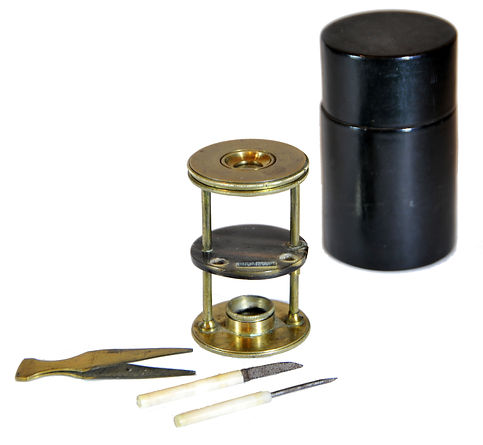

Withering-type botanical microscope, 1780
The “Withering-type Microscope” is named for its inventor, Dr. William Withering (1741-1799), an English physician and botanist who graduated with a degree in medicine 1766 in Edinburgh. Inspired by the taxonomical work and systematic classification of Carl Linnæus (1707-1778), Withering (1776) applied the Linnaean taxonomical system of classification to British plants in a seminal, two volume work, A Botanical arrangement of all the vegetables naturally growing in the British Isles. The earliest reference to a small botanical microscope of Withering’s design appeared in the first edition of this book. There, Withering indicated this microscope was developed for field dissections of flowers and other plant parts. While there is no surviving example of this exact design, close relatives of this type do exist, made either completely of brass or of ivory with brass pillars. Ivory models can be tentatively dated to 1776-1785, as by 1787 a newer model with a hollowed stage in an all-brass configuration already predominated. In turn, it was preceded by the brief appearance of a transitional brass model but with solid stage of ivory or horn (seen here). This version is extremely rare and must have been produced in very small numbers. By 1787 all these varieties were not recorded anymore in the literature.

Withering-type botanical microscope, 1780
The “Withering-type Microscope” is named for its inventor, Dr. William Withering (1741-1799), an English physician and botanist who graduated with a degree in medicine 1766 in Edinburgh. Inspired by the taxonomical work and systematic classification of Carl Linnæus (1707-1778), Withering (1776) applied the Linnaean taxonomical system of classification to British plants in a seminal, two volume work, A Botanical arrangement of all the vegetables naturally growing in the British Isles. The earliest reference to a small botanical microscope of Withering’s design appeared in the first edition of this book. There, Withering indicated this microscope was developed for field dissections of flowers and other plant parts. While there is no surviving example of this exact design, close relatives of this type do exist, made either completely of brass or of ivory with brass pillars. Ivory models can be tentatively dated to 1776-1785, as by 1787 a newer model with a hollowed stage in an all-brass configuration already predominated. In turn, it was preceded by the brief appearance of a transitional brass model but with solid stage of ivory or horn (seen here). This version is extremely rare and must have been produced in very small numbers. By 1787 all these varieties were not recorded anymore in the literature.
References: SML: A242712; Goren 2014.
References: SML: A242712; Goren 2014.
Prof. Yuval Goren's Collection of the History of the Microscope
Chapter 21: Livebox Microscopes
Livebox Microscopes of the 19th Century
During the Enlightenment era and the Age of Exploration, science became increasingly popular. The general public, which was becoming more literate and interested in knowledge and education, drove the growth of print culture and the spread of scientific learning. In Britain, this was reflected in the establishment of organizations like the Royal Institution, which aimed to promote the introduction and dissemination of useful mechanical inventions and improvements, and to teach the application of science to daily life through philosophical lectures and experiments. As interest in natural philosophy grew, hobbyists also became interested in exploring the world around them. They studied insects, microscopic fauna and flora, fossils, and mineral crystals. Wealthy amateurs could afford costly compound microscopes, but simpler microscopes were used by those who were less professional or well-to-do. However, even these modest microscopes were able to satisfy the curiosity and spread the knowledge of natural history to the public well into the 20th century.
Livebox Insectoscopes, ca. 1780 - 1820
During the early 19th century, people used lignum vitae or brass and glass single-lens live-box "insectoscope" microscopes. These microscopes featured a live glass box that illuminated insects, flowers, or minerals for inspection under magnification. Users could focus the microscope by rotating the screw-in lens in its milled housing. The magnification range was usually around x6 - x12.
These microscopes were simpler than the expensive ones used by professionals and were primarily used by amateurs interested in natural history, who could not afford the costly microscopes and prepared slides. Despite their simplicity, these microscopes helped satisfy the public's curiosity and spread the notion of natural history.
The livebox insectoscopes came in different forms and constructions. The examples shown here represent the two main forms used from the end of the 18th to the very beginning of the 19th century. However, they continued to appear in catalogues, such as that of Benjamin Pike's Son & Co, until the beginning of the second half of the century.

Inv. YG-20-025
© Microscope History all rights reserved
The photos above showcase two types of insect microscopes. The first one (YG-20-025) appears like a bottomless glass bottle featuring a lens enclosed in a brass frame at the neck. The fine-focusing can be achieved by rotating the lens-holder around the threaded tube. On the other hand, the second example (YG-21-034) comprises of a thick glass cylinder placed between two brass caps. The lens fixed at the top inside a brass frame allows one to observe a rolling wooden block with sets of beetles, shells, and seeds glued onto it. Both microscopes offer a magnification of about 4-8 times.
Additionally, we have a pocket-sized livebox microscope from the late 18th century or early 19th century (YG-21-036) that was designed to be carried to the field. To focus, the live specimen is placed between the two glass circles, and the eye lens can be screwed up or down. This useful little microscope is ideal for observing transparent or translucent objects.

Inv. YG-21-036
